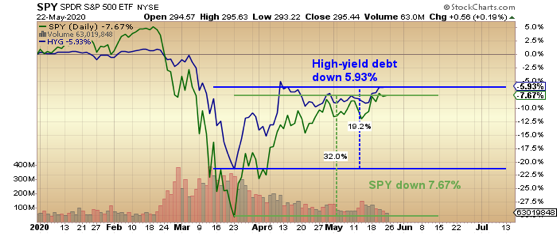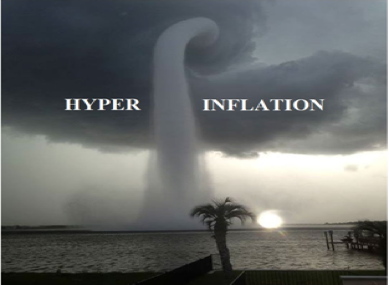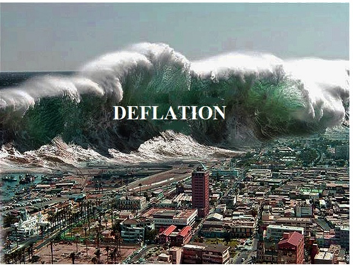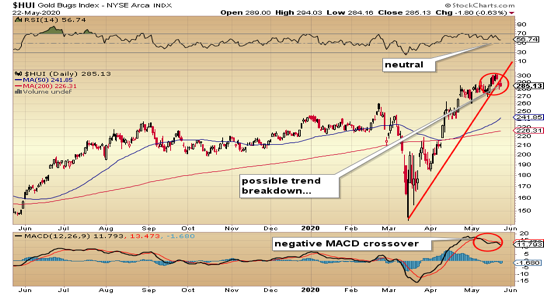Click here to get this article in PDF
Source: Michael Ballanger for Streetwise Reports 05/26/2020
Sector expert Michael Ballanger considers what the post-pandemic world could look like in the aftermath of central bank actions.
As I sit here on the shores of lovely Lake Scugog, its weed-infested waters lying in wait for countless unsuspecting propellers soon to be ensnared, I am reminded of the failed world of central banking and policy initiatives, which too has become ensnared in flora of its own making—a floating algae bloom of debt, deception and intervention.
Following this metaphor apropos, there is nary a dock with twenty miles of Port Perry that is navigable without encountering an impassable wall of goose droppings. Being Canada’s favorite bird, these creatures are the height of ornithological fecal incontinence. Sadly, as a “protected species,” citizens are prohibited from causing them not only any harm, but also inconvenience (as in shooing them off your property), resulting in spoiled lawns and malodorous decks and gazebos. When I see a flock of these flying manure sacks about to land on the lake, I am once again reminded of politics, where unelected officials are paid to engineer policies of unknown outcome and uncertain consequence, but where the result will be despoiled surroundings, economic disaster and odors of the foulest origin.
Alas, another thing held in common by a goose and the politician is that both can be found on a stamp, and both worth well under a dollar, and therein lies a lesson of sorts, a parable, a fable of resounding relevance.

I have spent the better part of a week listening to the pundits spouting off on the form and shape of the “recovery” once the lockdowns end and people start breathing on each other once again. It will be either “V-shaped,” “L-shaped,” “U-shaped,” or it might be shaped like a gigantic phallic symbol, headed squarely for the exposed hindquarters of the poor, the elderly, the retired, the unemployed, the single mom, the single dad and just about everyone except the 1% of the population being levitated both emotionally and financially by the Federal Reserve, the U.S. Treasury and the White House, all of which are totally and irrevocably obsessed with the stock market. Their focus is not the standard of living in the suburbs of Houston; it is the forward price-to-earnings ratio (P/E) of the NASDAQ.
Our policy-makers were raised in era of stock-based compensation, seed round investing, and behavioral finance manuals all centered around an economic theory called the “Asymmetrical Wealth Effect.” In this theory, those with stock portfolios feel better about spending when stocks are charging higher, resulting in a vibrant consumer-driven economy and the nascent trickle-down of that wealth from the uber-rich to the rich to the “sorta” rich, who spend every dime they have to resemble the uber rich by going into hock.
In Canada, unlike the U.S., the popular version of the all-sustaining ATM machine has been the real estate market, where the Conference Board of Canada just pegged the average house at negative 18% off the peak several months ago.
The collusion between the Canadian banks and the Canadian government is beyond rank; it is criminal. The one and only driver for the Canadian economy since the Great Financial Crisis (GFC) was housing, and what drove housing was immigration, and as long as the Chinese and Russian money could be laundered seamlessly by the Canadian banks, it drove up house prices and their obscenly profitable loan portfolios.
They were all doing the same thing; all feeding at the same trough, whether a hog or a sow or a piglet, such that when the immigrant rang the triangle, the grunting and snorting was drowned out by the screaming and clapping of the Canadian politicians, wildly waving pompoms from the bleachers. Bonuses soared and political donations flourished, and all was well in the hallowed halls of Bay Street.
Now, with malls toast and high-rise office towers vacant and everyone realizing that there is no longer a need to commute three hours per day, who is going to be paying rents and leases in these commercial real estate buggy-whip factories? The food courts in these malls are not going to be reopened with a Timmy’s, a MacDonald’s, and seventeen Asian wok emporiums serving soggy rice and two-day-old chicken balls; they are going to stay shut.
In case you have yet to figure out the direction of this missive, all the above is immaterial to the discussion of stocks because it is the belief held by Jerome Powell of the U.S. Federal Reserve, and Haruhiko Kuroda in Japan, and Tiff Macklem at the Bank of Canada, and all the rest of these global “disciples of doom” that as long as stocks remain elevated, consumers will spend and all will be good.
The $6 trillion as a first stab by the U.S. Fed is going to snowball, and when I factor in the global move to reflate the system against a massive tsunami of deflationary forces, it could make Zimbabwe in the ’90s look like Switzerland in the ’70s.
To wit, there are two major faults in the thesis held by Powell and Co.: 1) that the majority of Americans are stock market investors and that the S&P at 3,500 will prompt business owners to keep all of their employees at work; and 2) that a 35% unemployment rate and riots in the streets by those who do not own stocks will create an economic outcome that, in due course, craters the stock markets. Just as Newton’s Law commands that for every action, there is an equal and opposite reaction, a sharp stock market retest (of the March lows) could quite easily create an “Asymmetrical Poverty Effect” throughout the ranks of entrepreneurs, and that would be a nail in the lid of the V-shaped recovery coffin.

The SPY (exchange-traded fund [ETF] for the S&P 500), which trades at 1/10th of the SPX, bottomed on March 23 at 218.26, at the exact point where Powell and Steve Mnuchin announced they were ditching bazookas in favor of “The Guns of Navarone” in their “policy initiatives” (magic money). Since then, it has pretty much been straight up. The New York Fed has done everything in its power to prolong and promote the rally in stocks and corporate bonds, but while the former is (in my humble opinion) “fake,” the latter is even “faker,” because you normally do not have bond prices and stock prices rising together.
Since bond investors are infinitely wiser than stock investors, the bet has to be placed on corporate bonds over corporate equity because debt holders have first lien on assets well in advance of equity holders, who have only a stake in future profits through dividends. If the company has no revenue and a bunch of empty buildings where tenants are paying no rent because employees were ordered by the government to stay home, then it is forced to look after bondholders first because they hold all the power in a solvency-centric world.
This is precisely why the banks are happy as hell to use fantasy money to buy up all the high-yield garbage that got issued from 2009 to 2020 to fund stock buybacks, because they can lay it off to the perpetual “Superbid” emanating from the NY Fed. The other reason is that, while the “deplorables” (referred to by a certain female Democratic candidate in her 2016 run for the U.S. presidency) have no stock in their household gin mills, their turkey-shoot bosses do have stock portfolios. The deal is this: The NY Fed buys all of your bonds at a 50% premium to market, and you get your traders to keep the S&P “bid” until election time. So, the hedge funds that got a huge lift late last year from the REPO print-a-thon are now getting another huge lift from the high-yield-debt print-a-thon, and never the twain shall meet!
Now call me cynical or call me jaundiced or call me a sexagenarian grouch, but at the essence of this entire discussion is the emerging reality that whether we get a “cure” or a “vaccine” or an “anal hypodermic” to fix things, life as we knew it in 2019 is not going to revert to the norm for one simple reason: times have changed.
You all recall my missive from January, when I spoke of “distrust” as the number one risk to the stock market. I surmised that it was that very “distrust” that would drive precious metals higher and stocks lower. I was (eventually) proven right, but not after tremendous “kitchen heat,” which usually takes the poorly equipped males to the sidelines (and I meant that in an emotional versus anatomical context).
The conditions in markets today are as menacing as I have ever encountered. What I mean by “menacing” is that most traders can fade off the consensus view—that is, if fifteen trader buddies that I know (who have never owned silver) are asking me where they can get $350 million worth of “deliverable silver,” we have a serious problem.

There is no doubt that we have entered a collective narrative regarding the precious metals that currently rhymes with 2009 but may not exactly repeat it. The reason is that we had a financial crisis in 2008, whereas we have an economic crisis today. One industry nearly vaporized itself in 2007–2008, and was rescued by bailouts in 2009; today we have multiple industries, like the airlines, restaurants, shopping malls, autos and the associated service industries, all operating with drastically reduce revenues.
Compounding the problem is the debt created when all component companies in the S&P 500 borrowed heavily in the corporate debt market (think “high-yield”) to finance those massive stock buyback schemes into which insiders were allowed to exercise options, sell their stock and become enriched. Today, they are standing in a long queue, hands extended, palms up, hat-in-hand, awaiting government—er, taxpayer—bailout money.
Further exacerbating the problem (and soon to fuel the public outrage) is that Jerome Powell is now using illusory funding to prop up that ocean of toxic junk, which essentially condones the very corporate misbehavior that caused the problem in the first place.
In the world of trading and investing, there are a few cognitive biases that plague us, sometimes occasionally but more than often frequently, and the one that I find particularly beguiling is “recency bias.” A good example might be how I recall the recent 2009 recovery, which was based solely on Fed interventions, and draw the conclusion that since it worked back then, it must work now. Similar to that conclusion, the stimuli used from 2009 to 2011 caused investment flows to drive the precious metals to all-time highs, as generalist portfolio managers migrated into the space in droves. Since the massive money-printing exercises worked back then, they will work now, especially since the depth and dimension of the 2020 bailout action have been gargantuan compared to the 2009–2011, and from all indications, may continue to escalate.
This recency bias is an easy place to reside, because in the world of competitive money management, being underweight a top-performing sector while your competition is overweight is hedge-fund purgatory. They would rather have equal representation in a crashing sector with everyone overweight than be underweight in a rising one. I call it the “misery loves company” effect, and from a competitive viewpoint, it makes sense. From a common-sense viewpoint, it is lunacy.

Where I differ from the masses here in the spring of 2020 is that conditions in 2020 are vastly different than in the 2008 crisis. What is not different is that the underlying problem, and the proposed policy actions by the politicians and the central bankers, have little to do with the pandemic and everything to do with the root problem. That root problem is debt.
I have been writing about this for thirty years, and the more I rant and rave and throw darts at Jim Cramer pictures and (sometimes) empty wine bottles at television screens and quote monitors from ninth-floor windows (aimed squarely at the noggin of some latte-sipping, iPhone-reading investment banker), the more they keep piling on billion after billion (now trillions with a “T”) of counterfeit currency to the steaming mound of phony fiat that already exists!
The vast majority of precious metals bulls are tilted toward the hyperinflation camp, where this galaxy of new debt (created by those self-empowered to do so) will result in massive drawdowns in the purchasing power of all global fiat currencies. I must have read fifty articles since the March crash, and arrival of “QE [quantitative easing] to infinity,” calling for Weimar-like conditions on the immediate horizon, and while I appreciate the commutative property of arithmetic, what all of these articles forget is that there is no precedent in history for current global economic conditions. For that reason, I rate the odds of a deflationary collapse equal to the odds of a hyperinflationary conflagration.

The reason I am currently cautious (as opposed to be bearish) on virtually everything is that no one out there in the precious metals blogosphere has any concrete clue as to the future outcome, because there is no blueprint for successfully dealing with a) a pandemic and b) uncontrollable debt. Nowhere do I read that “debt reduction/destruction is deflationary”; all I read is that “money printing is inflationary.” But we had massive debt monetization in 2009–2011, and inflation rates stayed calm.
On March 14 of this year, I issued subscribers my “generational buying opportunity” for the gold miners (both senior and junior ETFs GDX and GDXJ), and the next trading session was the single best entry point in both price and timing in my forty-year career. I had cautioned everyone that while I was ragingly bullish long-term on gold and silver, I was fearful of a major correction in stocks, so we were flat the miners when the COVID Crash arrived.
Today, I am once again flat (and nervous) the big ETFs, but well positioned in the junior developers and carrying a 65% cash position. Why so cautious? It is because I do not know for certain whether or not I will wake up tomorrow morning with a deflationary tsunami crashing into all markets, including the precious metals. And as Mark Twain famously wrote: “It ain’t what you don’t know that gets you into trouble. It’s what you know for sure that just ain’t so.”
If this widely anticipated inflation “just ain’t so,” there will be trouble.
Originally published May 23, 2020.
Follow Michael Ballanger on Twitter @MiningJunkie.
Originally trained during the inflationary 1970s, Michael Ballanger is a graduate of Saint Louis University where he earned a Bachelor of Science in finance and a Bachelor of Art in marketing before completing post-graduate work at the Wharton School of Finance. With more than 30 years of experience as a junior mining and exploration specialist, as well as a solid background in corporate finance, Ballanger’s adherence to the concept of “Hard Assets” allows him to focus the practice on selecting opportunities in the global resource sector with emphasis on the precious metals exploration and development sector. Ballanger takes great pleasure in visiting mineral properties around the globe in the never-ending hunt for early-stage opportunities.
Sign up for our FREE newsletter at: www.streetwisereports.com/get-news
Disclosure:
1) Statements and opinions expressed are the opinions of Michael Ballanger and not of Streetwise Reports or its officers. Michael Ballanger is wholly responsible for the validity of the statements. Streetwise Reports was not involved in any aspect of the article preparation. Michael Ballanger was not paid by Streetwise Reports LLC for this article. Streetwise Reports was not paid by the author to publish or syndicate this article.
2) This article does not constitute investment advice. Each reader is encouraged to consult with his or her individual financial professional and any action a reader takes as a result of information presented here is his or her own responsibility. By opening this page, each reader accepts and agrees to Streetwise Reports’ terms of use and full legal disclaimer. This article is not a solicitation for investment. Streetwise Reports does not render general or specific investment advice and the information on Streetwise Reports should not be considered a recommendation to buy or sell any security. Streetwise Reports does not endorse or recommend the business, products, services or securities of any company mentioned on Streetwise Reports.
3) From time to time, Streetwise Reports LLC and its directors, officers, employees or members of their families, as well as persons interviewed for articles and interviews on the site, may have a long or short position in securities mentioned. Directors, officers, employees or members of their immediate families are prohibited from making purchases and/or sales of those securities in the open market or otherwise from the time of the interview or the decision to write an article until three business days after the publication of the interview or article. The foregoing prohibition does not apply to articles that in substance only restate previously published company releases.
Michael Ballanger Disclaimer:
This letter makes no guarantee or warranty on the accuracy or completeness of the data provided. Nothing contained herein is intended or shall be deemed to be investment advice, implied or otherwise. This letter represents my views and replicates trades that I am making but nothing more than that. Always consult your registered advisor to assist you with your investments. I accept no liability for any loss arising from the use of the data contained on this letter. Options and junior mining stocks contain a high level of risk that may result in the loss of part or all invested capital and therefore are suitable for experienced and professional investors and traders only. One should be familiar with the risks involved in junior mining and options trading and we recommend consulting a financial adviser if you feel you do not understand the risks involved.
